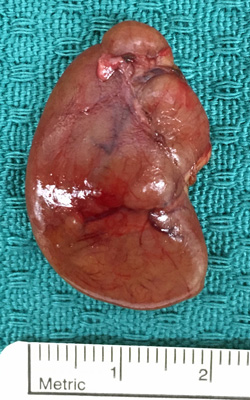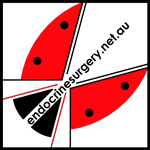Primary Hyperparathyroidism
 Fig. 1: A typical parathyroid adenomaThis is by far the most common form of hyperparathyroidism, with primary hyperparathyroidism (PHPT), affecting approximately 1 in 1000 people overall.
Fig. 1: A typical parathyroid adenomaThis is by far the most common form of hyperparathyroidism, with primary hyperparathyroidism (PHPT), affecting approximately 1 in 1000 people overall.
It is three times more common in women than in men, although under the age of 45 years the incidence is similar in both sexes. In women over the age of 45 years the incidence may reach 1 in 500, and even up to 1 in 100 in older women.
The average age at diagnosis is 55 years, with the majority of patients presenting between the ages of 40-70 years.
The incidence of hyperparathyroidism is increasing, as more patients are identified with a raised serum calcium, due to the widespread use of multichannel biochemical analysers. Typical presentation these days is the discovery of an elevated serum calcium during a routine health screen or during the investigation of an unrelated medical problem.
In addition, up to 29% of hyperparathyroidism patients will have co-existing thyroid pathology, of which 2% will have an occult thyroid cancer. Thus it is important that all parathyroid patients have a thyroid ultrasound as part of their workup.
-
Primary HPT Causes
While the causes of parathyroid disease in general are covered on the Overview of Hyperparathyroidism webpage, this page deals with the underlying surgical pathology which results in primary hyperparathyroidism.
-
Primary HPT Symptoms
Patients rarely present now with the symptoms of the classic description from the 1930s of "stones, bones, moans and groans", but tend to have a much more subtle set of symptoms, detailed on this page.
-
Primary HPTH Diagnosis
This page details the best way to investigate primary hyperparathyroidism in order to firstly establish the diagnosis, and secondly the imaging studies to localise the affected gland if possible.
-
Primary HPTH Treatment
The only cure for primary hyperparathyroidism is to remove the disease at surgery, particularly for symptomatic patients, and those with bone or renal disease. Guidelines for the management of asymptomatic patients are being refined regularly and are also detailed on this page.




